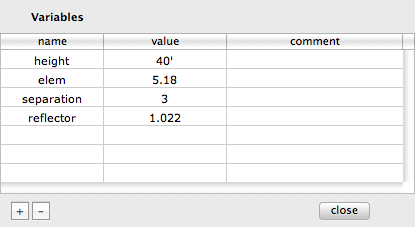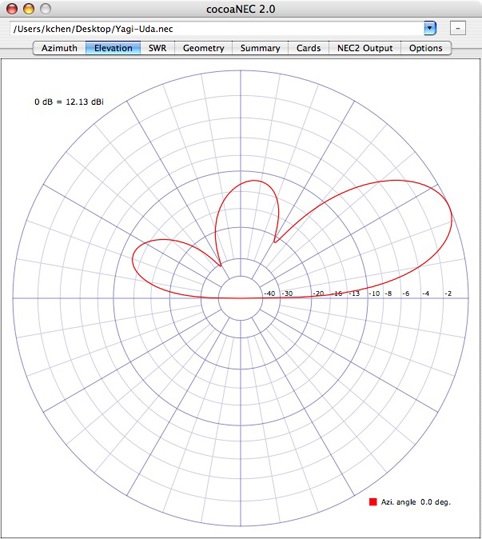7. Extending an Existing Model
We will now make a Yagi-Uda ("Yagi") antenna from your dipole model by adding a parasitic (without excitation) reflector element.
If you have your dipole model's window open, click on the title bar to make sure it is the active model. If you don't have the dipole model on your screen, use the Open Model or the Recent Model menu to fetch and open it.
Make the dipole spreadsheet the active window by clicking on its title bar, then pull down the Model Menu and select Duplicate Model.

When you duplicate the dipole model, cocoaNEC creates a new window for you that is called "dipole copy." Click on the title bar of the "dipole copy" window to make it the active window and save the newly created model (Save Model... in the File Menu) as Yagi-Uda. cocoaNEC will create a file named Yagi-Uda.nec for you.
If you open the Yagi-Uda's Variables sheet, you will notice that your dipole model's variables have already been copied there. Except for their names, the copy of the dipole model should be identical to the original model.
Add two variables named separation and reflector and assign them the values of 3 and 1.022 respectively.

Now add a new wire element to the Yagi's spreadsheet, and create the following formulas:
x1: -separation
y1: -elem*reflector
z1: height
x2: -separation
y2: elem*reflector
z2: height
radius: #14
segments: 21
The negative separation places the reflector element behind the driven element of the Yagi. Notice from the formulas for y1 and y2 that we have made the reflector 2.2% longer than the original dipole, now used as a driven element of the Yagi. I.e., the reflector element spans from minus element*1.022 to plus element*1.022.
When you are done, you should see the following:

Go to the File menu and choose Save to save this model.
If you hit the Run button, the Elevation pattern should change to the following:

The most obvious difference between this plot and the plot at the end of the previous chapter is that this antenna has developed a front-to-back gain ratio of about 11 dB. The main lobe of the Yagi has a gain of 12.13 dBi while the dipole has gain of 8.46 dBi, i.e., this Yagi has a gain of about 3.67 dB over the earlier dipole. The take off angle (the angle where the gain of the elevation plot peaks) of the Yagi is also just a little lower than the dipole's.